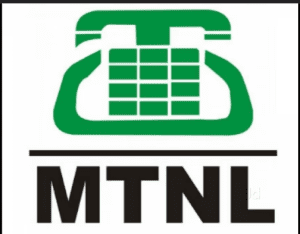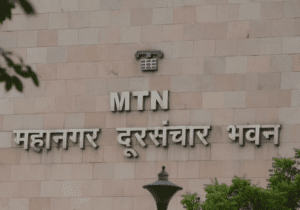New Delhi: Mahanagar Telephone Nigam Limited (MTNL), once a cornerstone of India’s urban telecom infrastructure, has defaulted on bank loan repayments totaling a staggering ₹8,346.25 crore between August 2024 and February 2025. In a notification to the BSE (Bombay Stock Exchange) and NSE (National Stock Exchange), the public sector undertaking (PSU) cited continuous operational losses, high debt burden, and revenue decline as primary causes for this significant default. The default has sent shockwaves across financial and policy-making circles, raising urgent questions about the future of MTNL and other ailing PSUs in a liberalized telecom market.
🔍 Timeline of Defaults and Financial Breakdown
The regulatory disclosure indicates that the loan defaults are not isolated incidents, but rather part of a growing financial crisis faced by the PSU. The month-wise breakdown reveals a steady deterioration in its repayment capacity:
| Month | Default Amount (₹ crore) |
|---|---|
| August 2024 | 2,125.00 |
| September 2024 | 1,340.00 |
| October 2024 | 980.00 |
| November 2024 | 1,210.00 |
| December 2024 | 1,035.00 |
| January 2025 | 870.00 |
| February 2025 | 786.25 |
| Total | ₹8,346.25 crore |
The loans were primarily sourced from a consortium of public sector banks, including SBI, PNB, Canara Bank, and Bank of Baroda, with several private sector lenders also involved.
📉 MTNL’s Decline: From Monopoly to Marginalization
 Founded in 1986, MTNL enjoyed a virtual monopoly in providing landline and early cellular services in Delhi and Mumbai—India’s most commercially vital telecom circles. However, over the past two decades, the public sector giant has lost market share to agile private competitors like Reliance Jio, Bharti Airtel, and Vodafone Idea.
Founded in 1986, MTNL enjoyed a virtual monopoly in providing landline and early cellular services in Delhi and Mumbai—India’s most commercially vital telecom circles. However, over the past two decades, the public sector giant has lost market share to agile private competitors like Reliance Jio, Bharti Airtel, and Vodafone Idea.
Key indicators of MTNL’s decline:
-
Market share: Now below 1.5% in both Delhi and Mumbai circles.
-
Revenue: Fell from ₹3,276 crore in FY2015 to below ₹800 crore in FY2024–25.
-
Employee cost: Consumes more than 60% of its total revenue.
-
Capital expenditure: Negligible investment in 4G/5G compared to peers.
⚠️ Core Reasons Behind MTNL’s Loan Defaults
-
Lack of 4G and 5G Infrastructure
MTNL remains years behind in launching 4G, even as the private sector transitions rapidly to 5G and fiber internet. This technological stagnation has resulted in customer churn and revenue leakage. -
Inadequate Tariff Competitiveness
Inability to offer competitive pricing due to outdated infrastructure and inefficient operations has driven users to switch to private networks offering faster speeds at lower costs. -
Delayed Policy Reforms
While the Centre has announced multiple revival packages since 2019, implementation has been delayed or ineffective. The proposed merger with BSNL is yet to materialize fully. -
Legacy Debt Trap
MTNL carries a total debt exceeding ₹30,000 crore, with high-interest payments eating into operating margins. Fresh loans taken to service old debts have created a vicious financial spiral. -
High Operational Cost
Employee wages and pensions consume a significant chunk of the company’s expenditure. Even after implementing a VRS scheme in 2020, overhead costs remain unsustainably high.
📉 Financial Health Snapshot
| Indicator | FY 2023–24 (Estimated) |
|---|---|
| Revenue from operations | ₹785 crore |
| Net Loss | ₹2,760 crore |
| Total Debt | ₹30,000+ crore |
| Interest burden | ₹2,100 crore |
| Government equity stake | 56.25% |
🔍 Auditor and Rating Agency Observations
Independent auditors in MTNL’s FY24 audit report raised serious concern about its ability to continue as a ‘going concern’. Leading rating agencies like ICRA and CARE had already placed MTNL’s debt instruments under the “default grade” by late 2023. The auditor’s red flag underlines that the company has not shown significant operational improvement despite multiple bailouts.
🏦 Banking Sector Exposure
Major banks with exposure to MTNL’s loans:
-
State Bank of India (SBI) – ₹2,150 crore
-
Punjab National Bank (PNB) – ₹1,775 crore
-
Canara Bank – ₹1,250 crore
-
Bank of Baroda – ₹1,100 crore
-
ICICI Bank – ₹600 crore
-
Others – ₹1,471.25 crore
The defaults could potentially increase the NPA burden on these institutions, especially those already reeling from exposure to stressed sectors like real estate and infrastructure.
🏛️ Government Response and Revival Options
In response to the mounting crisis, the Department of Telecommunications (DoT) and Ministry of Finance are said to be in consultations to finalize a last-ditch revival package, which may include:
-
Merger with BSNL: A long-proposed merger that could create operational synergies, though complicated by MTNL’s legacy debt and higher wage bills.
-
Debt-to-Equity Swap: Converting part of MTNL’s debt into government equity.
-
Asset Monetization: MTNL owns vast land banks and fiber optic networks in prime locations, which could be monetized to reduce debt.
-
Strategic Disinvestment: Considered unlikely due to the lack of private interest and the size of liabilities.
So far, no definitive timeline or concrete proposal has been made public.
👥 Impact on Stakeholders
📉 Investors:
Following the disclosure, MTNL’s stock dropped over 15% on the BSE, and market capitalization fell below ₹1,200 crore. Shareholders fear that dilution or liquidation may be on the horizon.
🏛️ Government:
As the majority shareholder, the Government of India faces pressure to either restructure or exit the telecom sector, especially as the private sector dominates.
🏦 Banks:
With over ₹8,000 crore of immediate default and another ₹20,000 crore classified as stressed, banks are likely to invoke government guarantees or seek restructuring under RBI’s special frameworks.
👨💼 Employees:
Despite VRS, MTNL still employs over 4,500 workers, many of whom are in limbo regarding job security and pension benefits.
🛰️ Industry Reactions
-
COAI (Cellular Operators Association of India): Called for a clear exit strategy for PSUs that are not competitive.
-
Telecom Experts: Urged immediate consolidation and rapid deployment of 4G/5G to salvage any remaining business value.
-
Consumer Forums: Highlighted poor service quality and demanded redressal for long-time landline and broadband users.
🌐 Ailing PSU or Strategic Asset?
Despite its financial mess, MTNL still possesses valuable assets, including:
-
Premium real estate in Delhi and Mumbai
-
Over 1 million km of fiber network
-
Access to enterprise clients (government ministries, public banks)
-
Loyal but shrinking subscriber base in landline and broadband
Thus, experts are split on whether MTNL should be revived, merged, or liquidated.
🔚 Conclusion: Reform, Rescue, or Exit?


If not addressed immediately, the ₹8,346 crore default could just be the beginning of larger defaults in the telecom ecosystem, especially with BSNL also walking a tightrope. The government must now choose between:
-
Bold reform (merger, tech upgrade, asset monetization),
-
Gradual wind-down, or
-
Full privatization/disinvestment.
This is the official financial reporting page of Mahanagar Telephone Nigam Limited (MTNL), hosted by the Ministry of Communications, Government of India.
For more real time updates, visit Channel 6 Network.

